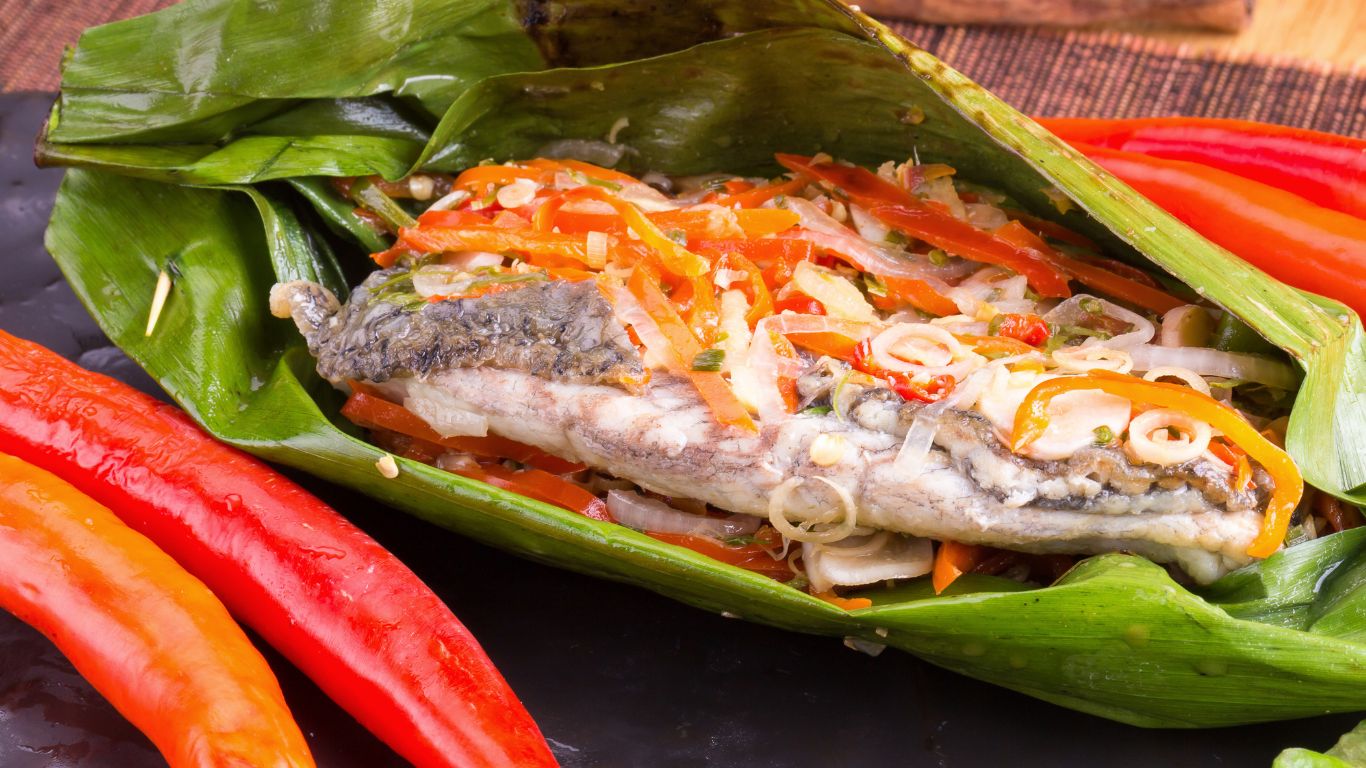Introduction:
Delving into the rich tapestry of global cuisines, one finds gems that not only tantalize the taste buds but also evoke a sense of tradition and authenticity. One such culinary masterpiece is the Steamed Fish in Banana Leaves, a dish that marries the delicate flavors of fresh fish with the aromatic embrace of banana leaves. In this article, we’ll explore the art of crafting this delectable dish, celebrating the union of tradition and taste.
The Tradition Behind the Dish:
Steamed fish in banana leaves is not merely a recipe; it’s a tradition rooted in various cultures around the world. From Southeast Asia to Latin America, this method of cooking has been passed down through generations, infusing the dish with cultural significance. Banana leaves, with their natural and robust properties, serve as the perfect vessel for steaming, imparting a unique fragrance to the fish while keeping it moist and tender.
Ingredients:
To embark on this culinary journey, gather the following ingredients:
- Fresh fish fillets (preferably white fish)
- Banana leaves (available in Asian grocery stores or markets)
- Aromatic herbs and spices (such as lemongrass, ginger, garlic, and cilantro)
- Lime or lemon for a zesty kick
- Coconut milk for a creamy texture
- Soy sauce for a savory depth of flavor
- Salt and pepper to taste
The Culinary Symphony:
Prepare the Banana Leaves: Begin by carefully washing the banana leaves to remove any dirt or debris. Cut them into square sheets, ensuring they are large enough to wrap the fish fillets.
Marinate the fish: In a bowl, create a marinade by combining finely chopped lemongrass, ginger, garlic, cilantro, and a splash of soy sauce. Add salt and pepper to taste. Coat the fish fillets generously with this aromatic marinade and let them marinate for at least 30 minutes, allowing the flavors to infuse.
Assemble the parcel: Take a banana leaf sheet and briefly heat it over an open flame to make it pliable. Place a marinated fish fillet in the center, add a few slices of lime or lemon for a citrusy twist, and pour a spoonful of coconut milk for a luscious texture. Wrap the banana leaf around the fish, creating a secure parcel.
Secure the Wraps: To ensure the banana leaf parcels stay intact during the steaming process, secure them with kitchen twine or toothpicks. This step is crucial to preserving the delicate flavors and preventing the escape of steam.
Steam to Perfection: Place the banana leaf-wrapped fish parcels in a steamer basket or on a steaming rack. Steam them for approximately 15-20 minutes, allowing the fish to cook gently in the fragrant embrace of the banana leaves. The result is a succulent and flavorful dish that captures the essence of the ingredients.
Serve with Love: Once the steaming process is complete, carefully unwrap the banana leaves, unveiling the aromatic and perfectly cooked fish within. Garnish with fresh herbs and serve it with steamed rice or your favorite side dishes. The presentation alone will entice your senses, and the first bite will transport you to a world of culinary bliss.
Conclusion:
Steamed Fish in Banana Leaves is more than a recipe; it’s a celebration of culinary heritage and the union of natural elements. As you savor each bite, you’ll not only enjoy the exquisite flavors but also partake in a tradition that spans across cultures and continents. So, gather your ingredients, embrace the art of wrapping, and embark on a culinary journey that promises a symphony of tastes and aromas.
FAQs
Why use banana leaves for steaming fish?
- Banana leaves are chosen for steaming due to their natural, non-toxic properties. They add a subtle, earthy aroma to the dish while effectively keeping the fish moist during the cooking process. Additionally, the leaves impart a unique flavor that enhances the overall dining experience. Visit
Where can I find banana leaves?
- Banana leaves are commonly available in Asian grocery stores or markets. Look for fresh, vibrant green leaves, and ensure they are clean before use. In some regions, they may also be available in the frozen section.
Can I substitute the type of fish used in the recipe?
- Absolutely! While the recipe typically calls for white fish fillets, you can experiment with different varieties based on your preferences. Fatty fish like salmon can add a rich flavor, while delicate white fish allow the aromatic marinade to shine through.
How do I know when the fish is cooked through while steaming?
- The fish is cooked when it easily flakes with a fork. Keep an eye on the cooking time, as overcooking can result in dry fish. If uncertain, you can make a small cut in the fish to check its internal color and texture.
Are there alternatives to coconut milk?
- Yes, you can substitute coconut milk with other liquids, like fish or vegetable broth, for a lighter option. For a creamy texture without coconut flavor, consider using almond milk or a combination of cream and broth.
